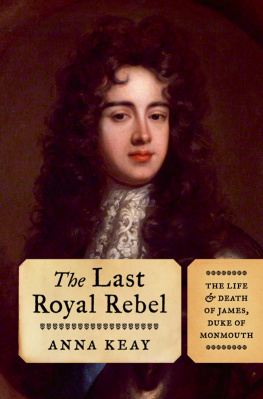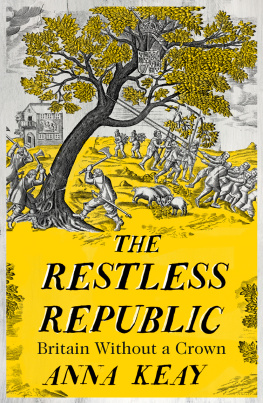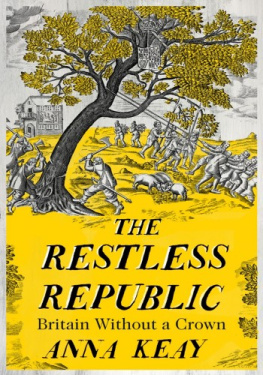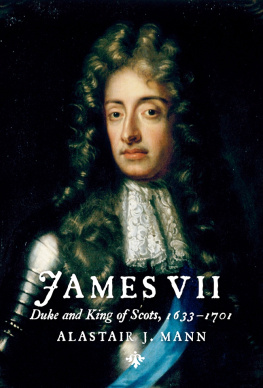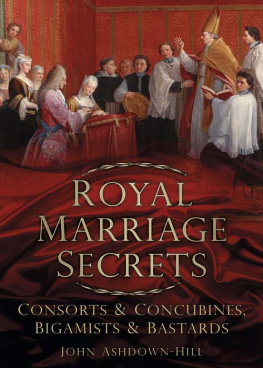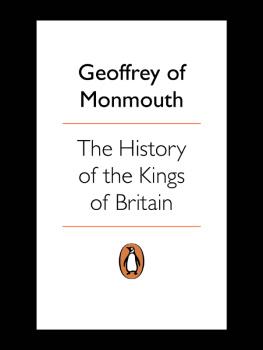THE LAST ROYAL REBEL
THE LAST ROYAL REBEL
The Life and Death of James, Duke of Monmouth
Anna Keay

For my father and mother
Contents
A Birds Eye View of Whitehall Palace, c. 1695 by Leonard Knyff. The Duke and Duchess of Monmouths lodgings centred on the five-bay, three-storey building towards the left of the engraving, facing the river across the Privy Garden. St Jamess Park, with its avenues and canal, stretches into the distance behind. Also overlooking the Privy Garden, viewed obliquely, is the Privy Gallery, rebuilt by James II. To the right of that, facing the river, is the Banqueting House. Carriages can be seen on King Street, the road which ran through the middle of Whitehall, passing on the right the gated forecourt of Horse Guards with its distinctive cupola. The Privy Stairs, the pillared royal landing stage, can be seen jutting out into the river against the later terrace.
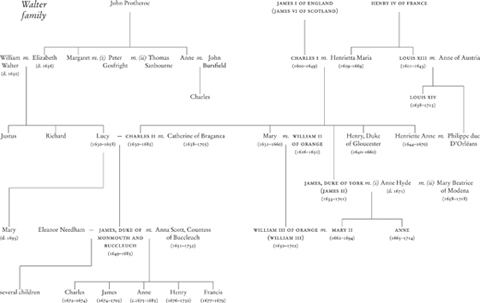
Born in the West Highlands of Scotland, Anna Keay read history at Magdalen College, Oxford, where she won two academic scholarships. She was awarded her PhD on the reign of Charles II by the University of London. She was formerly a curator for Historic Royal Palaces, Curatorial Director of English Heritage and is currently Director of the Landmark Trust. She is married with two children and divides her time between London and Kings Lynn, Norfolk.
The dates here are shown in the Old Style, Julian Calendar, for events in Britain (though with the new year taken to begin on 1 January) and in New Style, Gregorian Calendar, when the story takes place on the continent with both shown for clarity where relevant.
The original spelling has been retained in quotations throughout. These are broadly phonetic, so readers may find it useful to read words aloud if the meaning is unclear.
On a cold December evening in 1657 an English army officer loitered in the backstreets of Brussels, intent on abduction. His target, walking close by the side of an expensively dressed young woman, was an eight-year-old boy with dark eyes, a bright, animated face and brown hair that lay in soft curls on his shoulders.
The magnificent city of Brussels, which had once been home to the dukes of Burgundy, was now the capital of a satellite state of Spain, the Spanish Netherlands. From within the Coudenberg Palace, looming high in the darkness on its rising ground, a Spanish governor-general administered the region, brushing past the catafalque of the citys last Habsburg princess, Archduchess Isabella, as he went about his business. From its tapestried halls, his despatches were carried daily to his royal masters in Madrid.
Below the palace, in dimly lit alleyways, lurked the kidnapper, Sir Arthur Slingsby. Here, among inns, brothels and merchants mansions, lived his client a man who called himself King Charles II. He was the eldest son of the recently executed King Charles I, and grandson of both James I / VI of England and Scotland and Henry IV of France. But with his kingdoms now commanded by Oliver Cromwell, he had no government to instruct, no army to command, no palaces to occupy; his title was, in truth, more aspiration than actuality.
Slingsbys quarry was Charles IIs own son. His instructions were to take the child from Charless former lover, the notorious Lucy Walter. But as the kidnapper made his move, rather than a stealthy abduction, a violent public fracas unfolded. Wild screams of maternal horror drew crowds as Slingsby attempted to wrench the boy from his mothers arms. Lucys desperate cries whether of love, or of cold determination, it was impossible to tell echoed between the tall houses in the still, night air, receding only after the appalled onlookers intervened and carried mother and son to safety.
News of the incident spread swiftly across Europe, and a fortnight later King Philip IV of Spain received a detailed account of the event, which his agent described as most barbarous, abominable and unnatural.
To understand how this royal child had come into the world at all, and what a world it was, involves retreating ten years to the mid-1640s. Charles II was then still Prince of Wales, the seventeen-year-old heir to the thrones of England, Scotland and Ireland. Brought up in the rarefied world of the Stuart court, he had seen his universe turned on its head when civil war had broken out between his father, Charles I, and his subjects. The causes, though complex, stemmed largely from the kings determination to impose his florid and ceremonious form of religious worship on his three kingdoms. This was anathema to many of his subjects who preferred the simpler worship ushered in by the Protestant reformation. For four years Charles I fought the parliamentary army in a series of battles across the middle shires of England, before he was finally defeated.
During these years his son and heir Charles had turned from twelve-year-old bystander to active participant. In 1645, aged fifteen, the prince had been given nominal command of the royalist forces in the west of England. But the men he oversaw were no match for the increasingly professional and well-trained parliamentary army. Pushed further and further west, until he was pinned down in the south-western tip of Cornwall, he was finally forced to leave England in March 1646. As the prince sailed, Charles I had tried to bargain with his opponents, until, undone by his own intransigence, he was taken prisoner.
The young prince reached Paris in July 1646. Though this was the France of Louis XIV, the French golden age was yet to come: the Sun King was a boy of eight and Versailles still a hunting lodge. During this French minority political power had been vested in the hands of a regent, Louiss mother Anne of Austria, who was guided in everything by the powerful Italian prelate Cardinal Mazarin. Prince Charless mother, Queen Henrietta Maria, was the sister of the recently deceased Louis XIII and, being a daughter of France, had been warmly welcomed by her sister-in-law. Given apartments in the main royal palace of the Louvre, a summer residence at St Germain-en-Laye, and a substantial allowance, Henrietta Maria had established a new centre of gravity for the exiled royalists. It was to her court that Prince Charles reluctantly travelled in the summer of 1646.
Having already seen more than someone of his position might expect in a lifetime, Charles was at sixteen tall and dark and developing a fledgling moustache. He had the height of a man but had yet to throw off the self-consciousness of the adolescent. At eighteen he was described by a contemporary as one of the most gentle, innocent, well-inclyned Princes, so far as yet appears, that lives in the world [with] a trimme person, and a manlie carriage.
As Paris smouldered with Frances own political protests, the Fronde, in England Charles I was imprisoned in Carisbrooke Castle on the Isle of Wight, while his younger son, James Duke of York, made a daring escape from the parliamentary army disguised as a woman. All the while the Prince of Wales was consigned to playing pet to the great ladies of the French court, ever in the eye of his mother. Confined to his chamber by illness in the winter of 1647, Charless frustration must have been acute.
Then suddenly, in June 1648, everything in England seemed set to change. With the king captive and incapable of compromise, the possibility that there might be no reconciliation between Parliament and monarchy had started to become horribly real to both sides. As the moderates were being squeezed out of the parliamentary regime, the country began to enter uncharted territory. It was far from clear what would happen should Charles I continue to refuse the rebels demands. Many of the possible answers were unthinkable.

